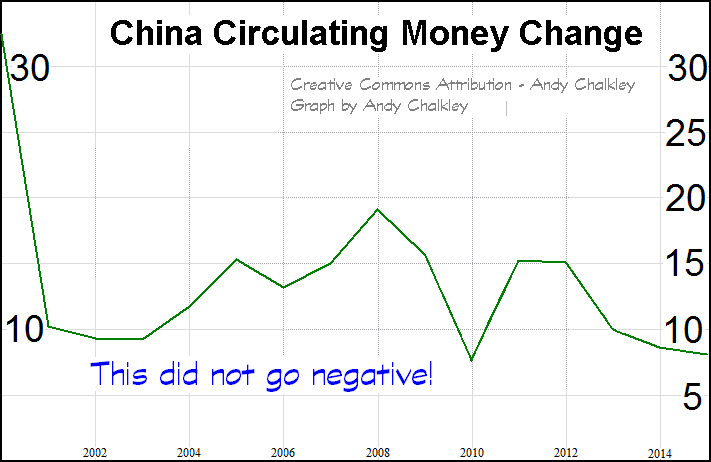
To calculate the percentage of Hoarded Money in society, I have chosen an arbitrary figure of one month. Money spent within one month is considered to be Circulating Money. Money sitting idle for more than one month is considered to be Hoarded Money. ‘One month’ is an arbitrary figure but it allows me to make calculations.
This diagram illustrates a Velocity of Two. Money changes hands twice each year. This puts Circulating Money at 17% and Hoarded Money at 83%.

This next diagram illustrates a Velocity of One. Money changes hands once each year. This puts Circulating Money at 8% and Hoarded Money at 92%.

Tax in society is almost exclusively removed from Circulating Money. Hoarded Money is almost completely untaxed. Most taxation creates a downward pressure on Circulating Money. Hoarded Money tends to be held by ‘persons-with-more-money-than-they-can-spend’. These people are adept at acquiring and holding money. They operate in a highly competitive manner to maximise their hoard. Collectively, they manage to get the taxation system adjusted so that they pay no tax on their hoards. To this end, they usually manage to eliminate:
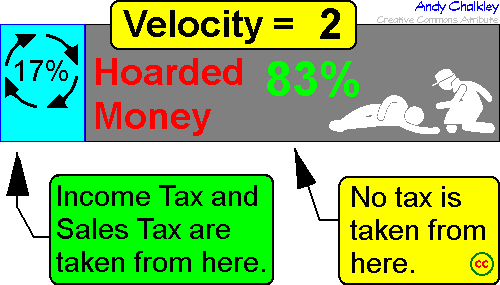
Most taxes are taken from the Circulating Money portion of the Money Supply. Almost nothing is taken from Hoarded Money. Sales Tax is a direct 10% tax on almost all transactions in the real economy. (Sales Tax conveniently avoids transactions made by rich speculators). Company Tax is a tax on profit from transactions and is removed from Circulating Money. Personal Income Tax is a tax on employment transactions and is removed from Circulating Money. Payroll Tax is particularly heinous. It is taken from the payroll of companies and conveniently avoids unearned income by speculators and hoarders. Personal income from sweat and toil attracts Payroll Tax but unearned income voids Payroll Tax.
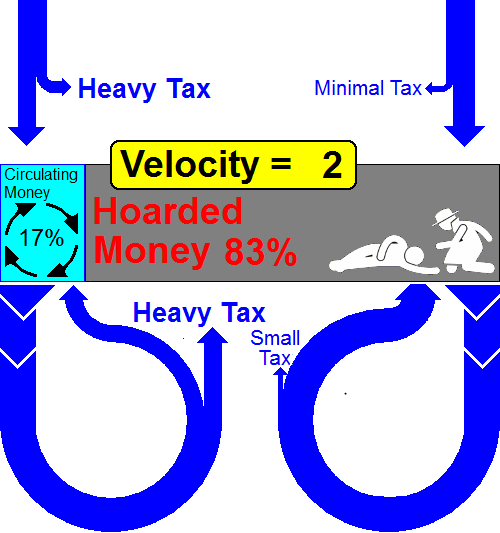
This next diagram shows the volume of revenue collected for each of the numerous taxes operating in Australia. Notice that most taxes are taken from Circulating Money. Money is taken at time of transaction or as the result of a string of transactions:

You might see, in the above graph, the inappropriate way that tax is currently collected. The first four taxes are an impediment to the ability of money to perform transactions. They reduce the volume of Circulating Money. They impede the circulation of money. The more that money is taxed, the more that Circulating Money is reduced. These four need to be progressively reduced and other taxes introduced and increased. Currently, we heavily tax transactions that involve goods or labour, but charge no tax on transactions that involve speculation or hoarding.

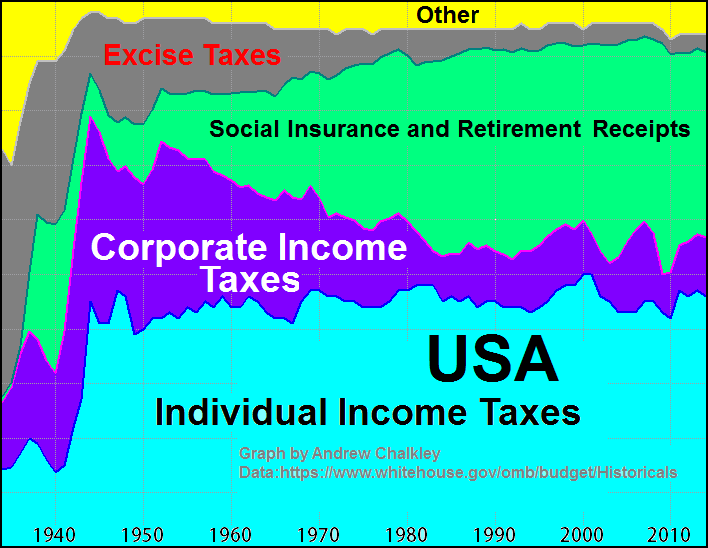
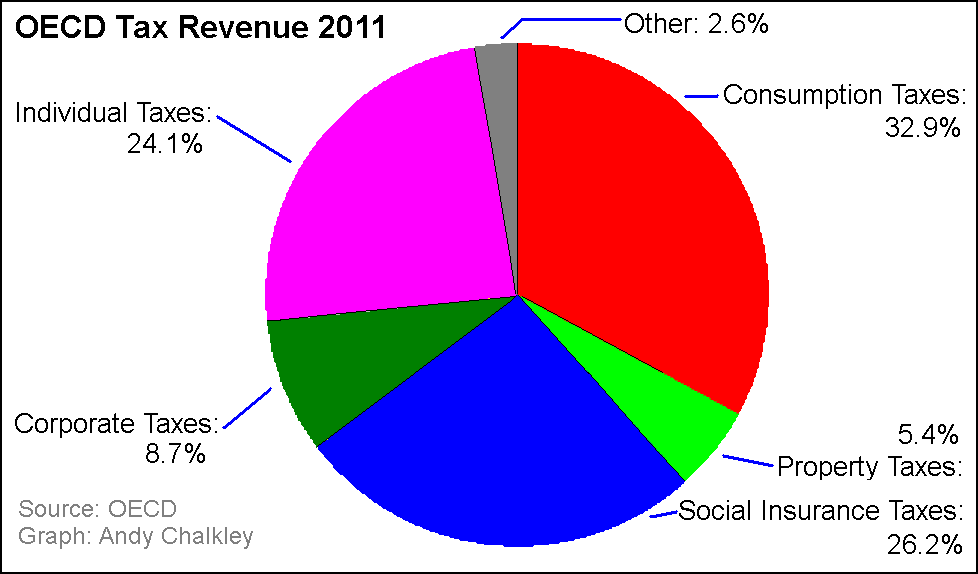
A large problem with this bias in tax collection towards Circulating Money is that it is counter-productive. When there is a fall in economic activity, the volume of tax collected falls. When the circulating money falls by say 1%, the tax revenue also falls. Worse than that, the fall in revenue is often greater than the fall in the circulating money. Study this graph carefully:

This encourages silly governments to magnify the problem by cutting government spending which is effectively a further reduction of Circulating Money causing a further fall in tax collection. (Although one can argue that what a government collects in tax, it spends back into society. However, the effect is negative rather than positive.) It is more appropriate for the government to increase spending at this time. I shall explain the mechanics of this in a while. This graph shows a fall in government revenue during a downturn:
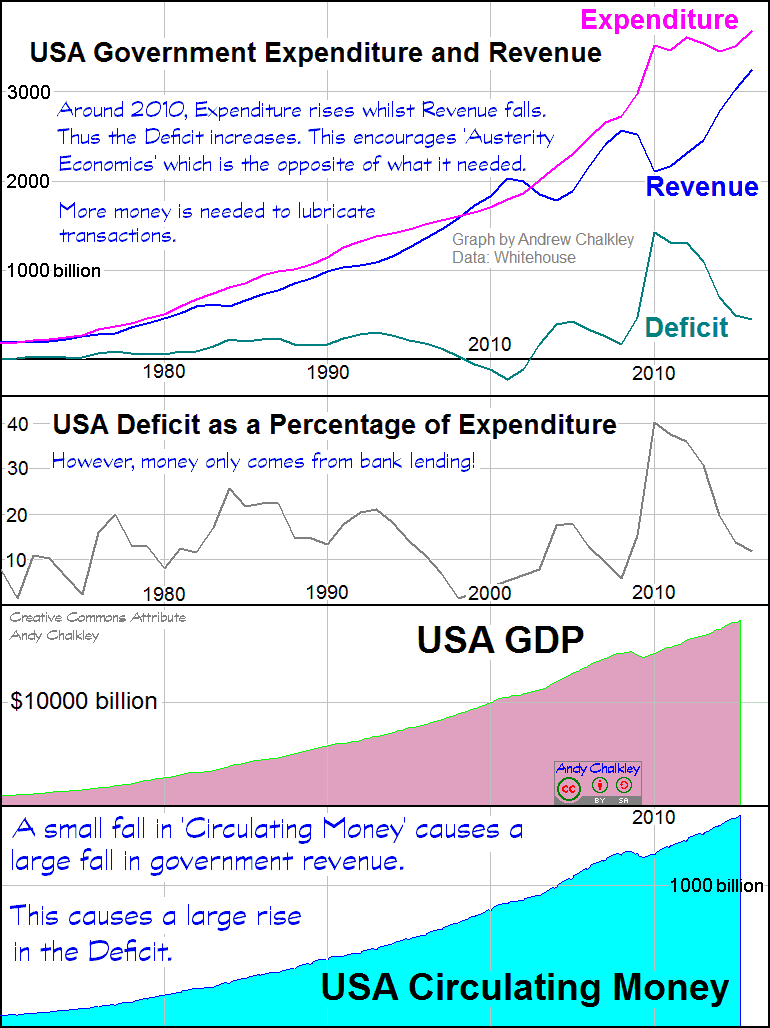
What is really bizarre is that the fall in revenue can exceed the fall in Circulating Money. This is incredibly significant.
This suggests that the government needs to increase the Circulating Money by, say, a billion to reap more than a billion in tax revenue. However, the government has difficulty injecting money such that is becomes Circulating Money. Government extra spending often falls into the hands of the hoarders.

In the above graph you can see that a very small fall in Circulating Money can cause an even larger fall in government revenue.
Let us consider this little story: I am driving across this big wide nation. I stop in a small town with an unpronounceable name that is constantly short of money. There are plenty of people wanting work. There is plenty of work to be done. There are plenty of goods for sale. Food is produced in excess. Unfortunately, no-one has money in their pockets. I go to the hairdressers and part with my hair and a twenty dollar note. The hairdresser goes next door to the pie shop and buys a box of meat pies. The pie man pays his apprentice twenty dollars in back pay. The apprentice goes out and buys a bunch of flowers for his girlfriend. The flower seller rushes to the vegetable shop and buys a box of apples and bananas. The shopkeeper goes to the cake shop and buys a birthday cake. The cake shop goes to the garage and pays the mechanic. The mechanic pays the apprentice. In one hour, my twenty dollar note has enabled $200 in transactions in a town full of people with empty pockets. They still have empty pockets, but they are all better off due to the travels of a single orange note. However, the apprentice goes to the local bar and buys a round of drinks. The bar owner has ‘more money than he can spend’ and takes the twenty dollar note to the bank where they write a larger balance against his name. Business activity ceases. As soon as people with ‘more money than they can spend’ get hold of money, they hoard the money. Not only do money hoarders remove money from circulation, they are a magnet for money because, as the volume of Hoarded Money increases, the chance that money will pass to a hoarder will increase. Money circulates well producing many times its own value in transactions until it is received by a person with ‘more money than they can spend’. Money then ceases to carry out its designed duty. The value of the orange note is not in the note itself, but in the transactions it enables. This is a fundamental misunderstanding of money. The value of money lies in the transactions it enables, not in the money itself.
So this little village in the middle of nowhere has plentiful food but hungry people all for the lack of a few twenty dollar notes to pass around. It is not wealth they need. The land is productive. The people are fit. They are not poor. They just need a few more twenty dollar notes to pass around to enable food to pass from the farmers to the hungry. It is transactions that they need, not money. They need to transfer apples, haircuts and labour between each other and money is the lubricant. They don’t need money to be rich as in: “Look! I’m rich. I have a wallet full of twenty dollar notes.” They become an affluent society because the orange notes were flowing. The notes need to exist AND be moving. The new twenty dollar notes will enable numerous wealth transferring transactions until someone hoards the money. Hoarding of money is a serious impediment to the maintenance of a successful and affluent society. Money needs to loose value to match or exceed the goods for which it is exchangeable. We currently do this through bank interest and inflation, but a better method is through demurrage. [Or government induced inflation. Here the government issues all money and manages a constant mild inflation.]
There are also at least two other incredibly serious problems with the hoarding of money which come later in the book. Maintenance of adequate Circulating Money is not just a national issue, it is also a regional issue. Adequate Circulating Money is needed in all regions of the nation. Many are the countries that I have visited where the capital city and surrounding regions are affluent and outlying regions are rundown. It is not just the magnitude of the Money Supply and Circulating Money that are an important part of the maintenance regime, the distribution of the money is important. Regional variations create their own microcosm and add to the inefficiency of the nation. You may have a negative attitude towards putting money into poor areas, but if a poor area has enough orange notes passing from citizen to citizen, it will no longer be poor and the area will add to the prosperity of the whole nation. Money put into poor areas is more than charity. It is the Money Supply and Circulating Money increase needed to make the area economically vibrant. Money given to a poor person is spent almost immediately often at a velocity of 365. Money given to a rich person may sit in a bank account for a few years and have a velocity of 1 or less. Money spent into poor areas compensates for the national habit of removing tax and interest from outlying areas and spending it from the capital city. This characteristic is very noticeable when traveling through Europe. In the former communist countries, you can still cross the road and the capital city is of moderate size. In the western capitalist cities, the capital cities are huge and are full of the youth of the nation who have migrated to the capital to effectively earn back the tax and interest paid from the countryside into the money coffers of the big cities.
When money is lent, the lender expects more in return than was lent. This is a mathematical impossibility and comprises an Impossible Contract. For this chapter, we need to discover from which section of the Money Supply the interest is removed. People that have ‘more money than they can spend’ do not need to borrow money. Those with insufficient money tend to borrow. Thus, all interest and repayments tend to come from Circulating Money.
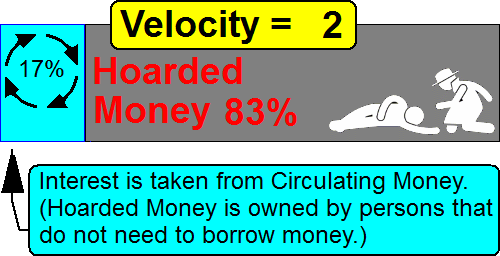
There is a constant downward pressure to reduce the velocity of money which is equivalent to increasing the percentage of Hoarded Money. Interest is paid by people that do not have adequate money to those that have ‘more money than they can spend’. Interest is an illness where Circulating Money is constantly drained into a constantly increasing pool of Hoarded Money. It is possible to have a situation where the total annual interest expense exceeds the magnitude of the Circulating Money

Some interesting observations can be made from the above diagrams. The first might be that a decrease in the Money Supply of only 8% has the potential to reduce the Circulating Money by 50%. This is reflected as a 50% fall in the GDP. An extremely small reduction in the Money Supply has the potential to cause a massive fall in the economic activity. [For the economists, it may be that a fall in M1 has a greater effect than a fall in M3. M1 is bank credit in bank accounts which is what citizens and businesses use for their business transactions, but it does not seem to show in the graphs. It may be that citizens hold on to their M1 in a downturn.] The logic is that reductions in the Money Supply almost always come from the Circulating Money. Circulating Money, by its very nature, is moving from person to person in a frequent manner. Hoarded Money stays with one a determined hoarder for extended periods. The hoarder tends to monitor his money hoardings and put his life effort into increasing his hoardings. Money is most easily removed where it changes hands frequently. Removed money is less noticeable to the citizenry when it is removed at the time of a transaction. Tax is least resented by the citizens when it is removed at the time of money movement. Thus, it is always the Circulating Money that decreases at times of financial stress with devastating effects on the economy. If the Circulating Money remains constant, the economy experiences a recession. If the Circulating Money falls, the citizenry experiences a depression with fall in economic activity accompanied by loss of jobs. (There are a few other factors at play here.) This graph for Canada shows a small fall in the Money Supply with a large fall in Circulating Money:

A fall in the Circulating Money causes a coresponding fall in GDP:

Notice that the government created Cash Currency did not fall:

When the Money Supply falls, the bulk of the reduction occurs where it hurts most, in the Circulating-Money component of the Money Supply. This magnifies the effect of the decrease. A fall in the Hoarded Money will have no effect on economic activity. GDP should remain constant during a fall in Hoarded Money. In a nation with a high level of Hoarded Money [low-velocity nations], the greater the effect will be. In a low-velocity nation, the GDP will be extremely sensitive to minor falls in the Money Supply. The Canadian example that I give has a 1.6% fall in the Money Supply M3 that causes an 8% fall in Circulating Money and an 8% fall in GDP. The fall in Circulating Money tends to cause a fall in Tax Revenue:

Graphs of the Great Depression are always fascinating to look at even though they were not fun for the victims of this inappropriately-named event. Have a look at these graphs for the Great Depression Graph. In 1929, Velocity = 1.95 and in 1932, Velocity = 1.3. By 1937, the Money Supply had recovered to its pre-depression value, but the velocity did not recover until 1943 and then there was another fall. Much of the increase in the Money Supply from 1934 had been commandeered by the hoarders. You can see from the graphs that the increase in the Money Supply after 1934 largely became Hoarded Money. Do notice that the cash currency, issued by the Federal Reserve, did not fall. This was not a government created depression. This was a ‘money drought’ caused by the lack of bank lending. If the government had owned a Public Bank, the government could have created loans to business, industry, and government to top-up the shortfall of money in the system.
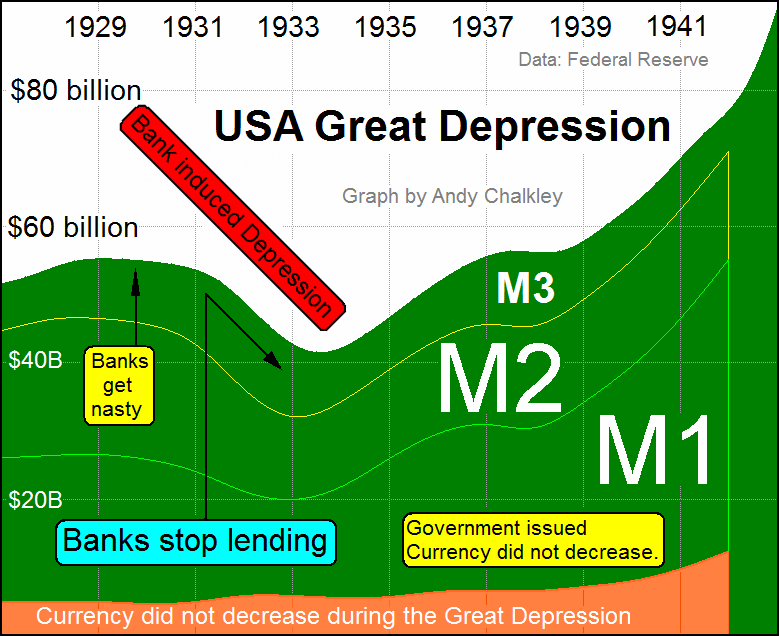


It does not follow that an increase in the Money Supply will lift the economy as the increased money tends to find its way to those with ‘more money than they can spend’ and thus, the new money gets hoarded. Businesses are fairly careful to use their money sensibly, spending exactly on the needs of the business. Circulating Money is following millions of well organised circular paths in a sort of myriad of economic microcosms. When brand new money is pushed into the real economy, its chance of finding its way into constant movement is slim. It is more likely to find its way to the opportunistic who will hoard it. If you want to recover an economy, it is better to go round villages and towns and give out small denomination notes to poor people in the street who will spend it the same day. This will add money to each and every existing economic microcosm, increasing the blood flow in all blood capillaries. It is better to send out a bonus with welfare cheques, for the money will be spent within a week into all local business activities. The expression Helicopter Money has the same effect. Sprinkle money from a helicopter in small denomination notes so that people spend it quickly straight into the Circulating Money component of the Money Supply. To lift an economy, money needs to become Circulating Money, which lifts economic activity. That is not easy. Destroying Circulating Money is easy. Increasing Circulating Money is difficult. Destroying economic activity is easy. Generating economic activity is difficult.
Circulating Money is shown in this graph:
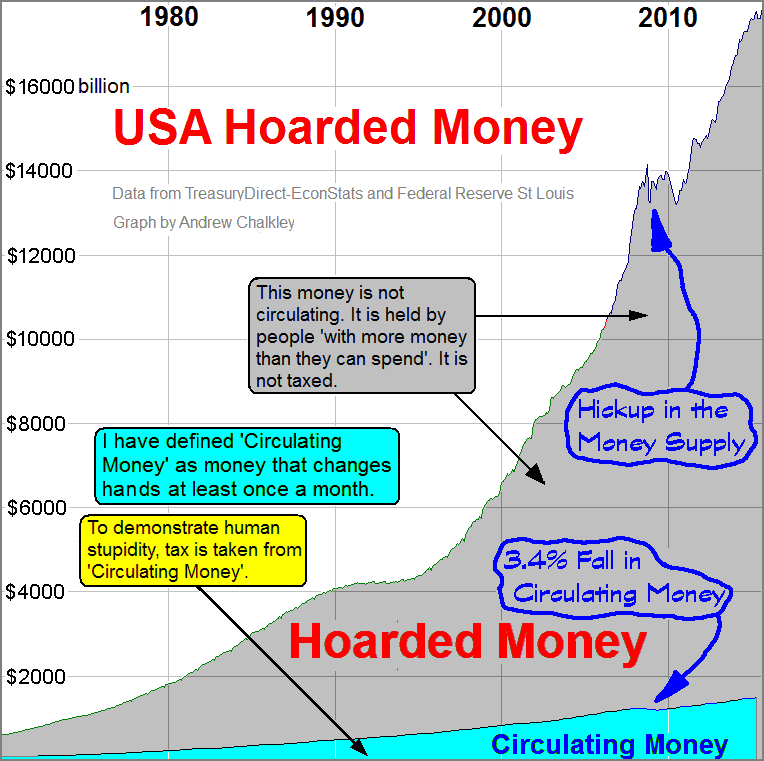
The change in Circulating Money during the financial crisis of 2008 is shown in this next graph. Notice that it went negative:
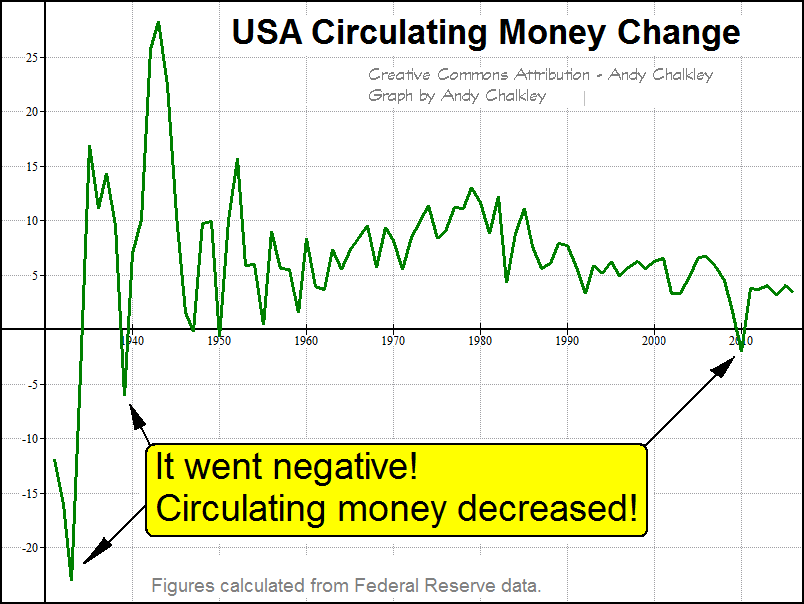
Notice that recessions occur where the ‘Change in Circulating Money’ is negative. China did not suffer to the same extent:
